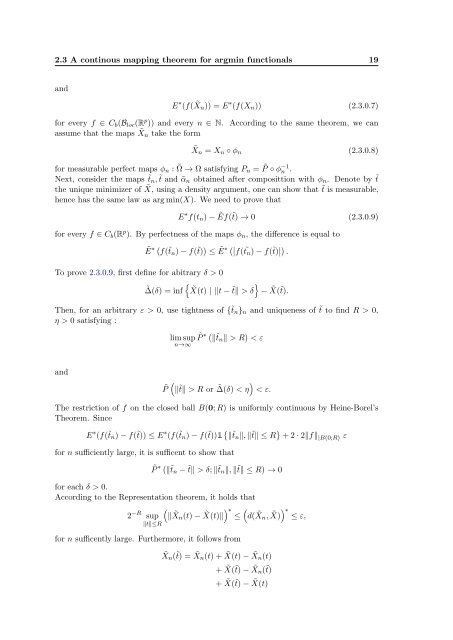Subsampling estimates of the Lasso distribution.
Subsampling estimates of the Lasso distribution.
Subsampling estimates of the Lasso distribution.
You also want an ePaper? Increase the reach of your titles
YUMPU automatically turns print PDFs into web optimized ePapers that Google loves.
2.3 A continous mapping <strong>the</strong>orem for argmin functionals 19<br />
and<br />
E ∗ (f( ˜X n )) = E ∗ (f(X n )) (2.3.0.7)<br />
for every f ∈ C b (B loc (R p )) and every n ∈ N. According to <strong>the</strong> same <strong>the</strong>orem, we can<br />
assume that <strong>the</strong> maps ˜X n take <strong>the</strong> form<br />
˜X n = X n ◦ φ n (2.3.0.8)<br />
for measurable perfect maps φ n : ˜Ω → Ω satisfying P n = ˜P ◦ φ −1<br />
n .<br />
Next, consider <strong>the</strong> maps ˜t n , ˜t and ˜α n obtained after composittion with φ n . Denote by ˜t<br />
<strong>the</strong> unique minimizer <strong>of</strong> ˜X, using a density argument, one can show that ˜t is measurable,<br />
hence has <strong>the</strong> same law as arg min(X). We need to prove that<br />
E ∗ f(t n ) − Ẽf(˜t) → 0 (2.3.0.9)<br />
for every f ∈ C b (R p ). By perfectness <strong>of</strong> <strong>the</strong> maps φ n , <strong>the</strong> difference is equal to<br />
Ẽ ∗ ( f(˜t n ) − f(˜t) ) ≤ Ẽ∗ (∣∣ f( ˜ t n ) − f(˜t) ∣ ∣ ) .<br />
To prove 2.3.0.9, first define for abitrary δ > 0<br />
{ }<br />
˜∆(δ) = inf ˜X(t) | ‖t − ˜t‖ > δ − ˜X(˜t).<br />
Then, for an arbitrary ε > 0, use tightness <strong>of</strong> {˜t n } n and uniqueness <strong>of</strong> ˜t to find R > 0,<br />
η > 0 satisfying :<br />
lim sup<br />
n→∞<br />
˜P ∗ ( ‖˜t n ‖ > R ) < ε<br />
and<br />
˜P<br />
(<br />
‖˜t‖ > R or ˜∆(δ)<br />
)<br />
< η < ε.<br />
The restriction <strong>of</strong> f on <strong>the</strong> closed ball B(0; R) is uniformly continuous by Heine-Borel’s<br />
Theorem. Since<br />
E ∗ (f(˜t n ) − f(˜t)) ≤ E ∗ (f(˜t n ) − f(˜t))1 { ‖˜t n ‖, ‖˜t‖ ≤ R } + 2 · 2‖f‖ |B(0;R) ε<br />
for n sufficiently large, it is sufficent to show that<br />
˜P ∗ ( ‖˜t n − ˜t‖ > δ; ‖˜t n ‖, ‖˜t‖ ≤ R ) → 0<br />
for each δ > 0.<br />
According to <strong>the</strong> Representation <strong>the</strong>orem, it holds that<br />
2 −R sup<br />
‖t‖≤R<br />
(<br />
‖ ˜X n (t) − ˜X(t)‖<br />
) ∗ (<br />
≤ d( ˜X ˜X)) ∗<br />
n , ≤ ε,<br />
for n sufficently large. Fur<strong>the</strong>rmore, it follows from<br />
˜X n (˜t) = ˜X n (t) + ˜X(t) − ˜X n (t)<br />
+ ˜X(˜t) − ˜X n (˜t)<br />
+ ˜X(˜t) − ˜X(t)
















